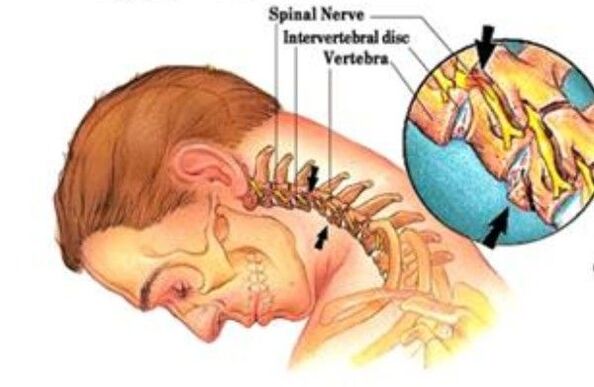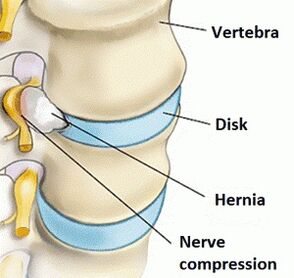
The pain in the neck is an exciting sign.Maybe you just have to overvolate this and just relax and relax.But what happens if pain is related to the osteocondrosis of a cervical spine?It is important to consider symptoms and treatment carefully because complications can affect the most important body - the brain.
What is cervical osteocondrosis
Osteocondrosis of cervical spine is a degenerative disease of the body's bone cherry system.This causes the destruction of cervical intervertebral disks and increase the bone tissue of vertebrae and growth in surfaces.
The cervical spine consists of seven vertebrae expressed by the first skull.The anatomical and functional unit of the spine is the spinal-motor segment.This is the joint complex moving the spinal column.The complex consists of two vertebres, intervertebral disks, ventbs (facet), two vertebraates of nerve, ligaments and articular surfaces of the muscles.
Osteochondrosis damage the intervertebral disk and affects all the surrounding tissues.Over time, the trial is a whole, causing a violation of the waist biomechanics.With the development of osteocondrosis, intervertebral disks can form the hernias, nerve roots and blood vessels.
The pathological processes on the intervertebral disk are four stages: Diet, the weakening of ligaments, disk damage and nerves are harmed.

- Stage 1.The terms and conditions of the intervertebral disk are violated.Due to the characteristics of the structure, the disks are eaten only during movement.If this is not the case, the dystrophic tissue changes begin: the disc is hungry and dehydrated.Water loss causes the intervertebral disk to fulfill their depreciation functions.Fibrus the load in the ring is strengthened, cracks and tears appear.It may seem small pain at the moment.
- Stage 2.In the second stage, the ligamentoz of the vertebral segment occurs.The connection is pathologically mobile.The pathological process on the disk is worried, the hernia (prolapse) begins - the papose core is followed by cracks in the fibrous ring.The pain periodic.
- Stage 3.In addition, the intervertebral disk is completely damaged.The skin of the disk goes beyond the fibrous ring.The resulting hernia can break the nerve roots.The inflammatory process is developing.This reflects the exacerbation of pain and reflects so many levels of radicular syndrome.
- Stage 4.In the fourth stage, the defeat affects the nearest parts.It is possible to squeeze the radicular artery, which causes the lack of blood supply to the spinal cord.As a result, the spine can be completely immobilized.
First signs and basic symptoms
Development of osteocondrosis of the cervical region, anxiety, movement restrictions, pains of the neck.It often doesn't care.
With time, pain, pain, burns, head, neck, neck, shoulder blades, shoulders damage - perhaps this develops the syndrome of vertebral artery.The artery is compressed or spasmodic, blood flow is broken.
In the 1-2 stage of cervical osteocondrosis, ophthalmological problems related to spasms in ships are often.In the eyes, darkening, whip, "flies", colored spots in front of the eyes - all of them are osteocondrosis symptoms.
The most common symptoms of cervical osteocondrosis:
- Migraine, dizziness, nausea and cough.
- Hearing barrier, pain in the ear.
- Motor disorders in the hands, legs.The sensitivity of the skin in the head can be a gap.
- The pain in hand.If a nervous waist is squeezed, the whole area sent to the impulse can damage or "falls".
In addition to the above symptoms, you can distinguish three main pain syndrome, accompanied by three main pain syndrome accompanied by the cervical waist.The syndrome is a complex of all symptoms.It is important to determine the leading pain syndrome, because the whole treatment regime is clear to remove the pain.And without knowing the origin, it is impossible to eliminate it.
- Miofascial syndrome- Pain in skeletal muscles and adjacent to it.The order is associated with excess download, which occurs in pain, hypertonicity, painful knots (trigger points) in the muscles.
- Rook syndrome- pain that causes the roots of the spinal nerves for a long time.Hernial formation process for osteochondrosis of the spine causes a pinch of nervous fibers and the subsequent inflammatory reaction.Pain spread across the nerve.
- Facet syndrome- pain in vertebrates.The second cervical has articular processes connected to each other with vertebrae, arched (Facet) combinations.With osteochondrosis, intervertebral disks are destroyed, the height is reduced, and this causes constant tension of joint capsules of clogging compounds.This causes pain.Moreover, pain increases by a long time, especially for a long time until the end of the day.
Reasons for osteocondrosis in cervical spine One of the main reasons for osteocondrosis is evolution to a high vertebrate load.People's ancestors went to four feet like other mammals.In the horizontal position of the body, they did not suffer from osteocondrosis because the pressure pressure was vertically.According to the standards of evolution, the transition to correction did not happen before and the spine was not the time to simply adapt to a high vertical load.Thus, along with the correction, a person also gained diseases of the Musaloshelet system.
A person is more sensitive to his structure.A man's cervical department consists of seven small mobile vertebraes expressed by the type of children's pyramid.This design can be stable outside the rest of the rest.In addition, the muscle frame in this zone is weak and loads can be higher - it all is sensitive.Full of any injury to any injury.Even if the damage is in another waist, the redistribution of the load can cause osteocondrosis.
Another factor is aging.The formation of a piece of skeletons and cartilage ends 21 and then the irregular process of aging (degeneration) starts.Cartilage foods are carried out only due to the spread and the intervertebral disk does not receive nutrients, gradually begins to collapse.
In addition, the development of cervical osteocondrosis:
- Otoimmune Diseases.The destruction of cartilage tissue attract its body cells in the pathological process.
- Infections, hormonal shortcomings, slowdown in metabolism - all these turnover disorders may be factors for the development of osteocondrosis.
- A sedentary lifestyle, where a person spent most of the compulsory static condition, working conditions.
- High loads causing injuries can cause compression.
- Genetic defects, the weakness of the musaloshelet system and the lack of cartilage fabric.
The cervical spine is very narrow in the spinal canal, so high loads, any violations or injury can cause the spinal cord.And this is very dangerous.
In addition, there are a large number of nervous tips and blood vessels in this area.If the blood stops flowing into the brain in the correct volume, it can be a shot.
Diagnosis
The medical diagnosis of cervical osteocondrosis collects the history of the patient.It is how it hurts, how frustrated, this is how much it is, or in a rest, which is more powerful regardless of the cervical waist of the day.
During the neck inspection, the doctor feels cervical vertebrae and muscles, lymph nodes;Evaluates the volume of movements, excludes or approves the provision of Ruzer syndrome.
After that, a laboratory diagnosis to exclude autoimmune diseases: a common blood test, Esr, Rheumatoid factor, Antigen HLA B27.
The main role in diagnosis is given to the rentomography, calculated tomography and magnetic resonance.
- RntgenographyIt helps assess the situation of bone structures, not shown soft tissues and cartilage in pictures.The contrast environment is provided to visualize these structures: angiography, discography, myelography.
- Calculated Tomography (Ct).This method also uses the principle of radiography, but using computer processing, you can get a number of tall and transvers sections that you can see bone and cartilage.
- Magnetic Resonance Tomography (MRI).Infection, including the diagnosis of cartilage and soft tissues, is "gold standard".The MRI only gives an idea of the structure of the organ and tissue, as well as their activities.In the event of osteocondrosis, which is often a complication, there is a spine.MRI allows you to diagnose the process of forming a hernia in early stages.
Treatment
The treatment of osteocondrosis of cervical spine is reduced to conservative methods.Initially pain syndrome is removed and then different procedures are determined.However, in the most extreme cases, if the pain is not exceeded for more than three months and does not help medication, surgery is becoming a way of surgery.
-Surgical treatment methods
Osteochondrosis bone-ологели system hit for more than a year and therefore treatment will take time.Should gain patience.Conservative Treatment Tasks:
- Eliminate the pain.
- Remove inflammation.
- Restore functions of spinal roots.
- Strengthen muscle corsets and ligaments.
Conservative treatment includes medicinal therapy and physiotherapy.Preparations help to eliminate the pain during weight and physiotherapy - to start the processes denying yourself.
During a severe pain with radical syndrome, the idea is carried out in the "blockade": the drug is applied near the inflammatory waist of the spinal nerve.
Physiotherapy treatment is based on natural and artificially reconstructed physical factors: cold, heating, electric current, magnetic radiation, laser and others.Their reconstruction, special devices, devices, hand methods are used.
- Laser therapy- Biological activation of recovery processes of intervertebral disks.The body begins in -heal.
- Plazmotherapy (PRP therapy)- Injection of the patient's blood isolated plasma.Plasma platelets are rich in growth factors, hormones.After injection, local immunity is rising and recovery processes are launched.
- Acupuncture- Stimulation of nervous ends with special needles.Improves metabolism in affected areas, eliminates the pain.
- Shock wave therapy- exposure to high levels of waves.Allows you to start natural recovery processes.
- Kinsaperapy- movement therapy.Can be active (exercise therapy) and passive (massage, traction).LFK strengthens the back muscles, removes traction tension and pain.Selected by taking into account the individual's individual features.
- Hand therapy and massage- Soft tissues and joints to restore the balance in the body and regain synchronization of processes.Return Mobility and eliminate the pain.
- Delay- Paste special placels on the skin where the muscle extension and compression should be affected.Both can relax and increase the tone.
It is recommended to wear special bandages and collars for the neck from the patient in the acute pain period.
The positive effect of conservative treatment is obtained in 2-3 months.If there is no result, the patient is recommended.
Surgical methods of treatment of osteocondrosis
In the case of cervical osteocondrosis, the operation is the extreme measurement of special indicators.The operation is recommended:
- Pain cannot be removed with therapeutic treatment for more than 3 months.
- There is a hernia from intervertebral disk.
- The sensitivity in the fairness disappears
Post-operation rehabilitation also takes time and may include therapeutic treatment.
The cervical osteocondrosis complex is a degenerative disease.You can't treat it.Such serious violations in the muskuloskeletal system can cause disability.The pain in the neck can be chronic, osteochondrosis will spread to several parts of the spine.In-time prevention can prevent the development of this disease.
Prevention
The cervical spine needs daily physical activity to protect the health of the spine.The food of intervertebral disks occurs in motion, so it is extremely necessary.It is important to have the cargo optimal and regular.
If the work is connected to constantly finding a steady position, a periodic warming is needed.After a working day, you can sleep on a flat surface after a while, put a roll for a while.This method will help to restore the cervical bending of the spine and remove muscle tension.
In preventing cervical osteochondrosis, it is important to pose properly during sleep.If a man in the morning rises with pain in his neck, the muscles did not have time to rest and restore.
Here, an orthopedic pillow selected individually, will help for 3-5 years.
Do not delay the treatment
A doctor will help you choose a recovery program.He will evaluate the condition of the spine in MRI and will be the likelihood of resorption and the probability of treatment.























